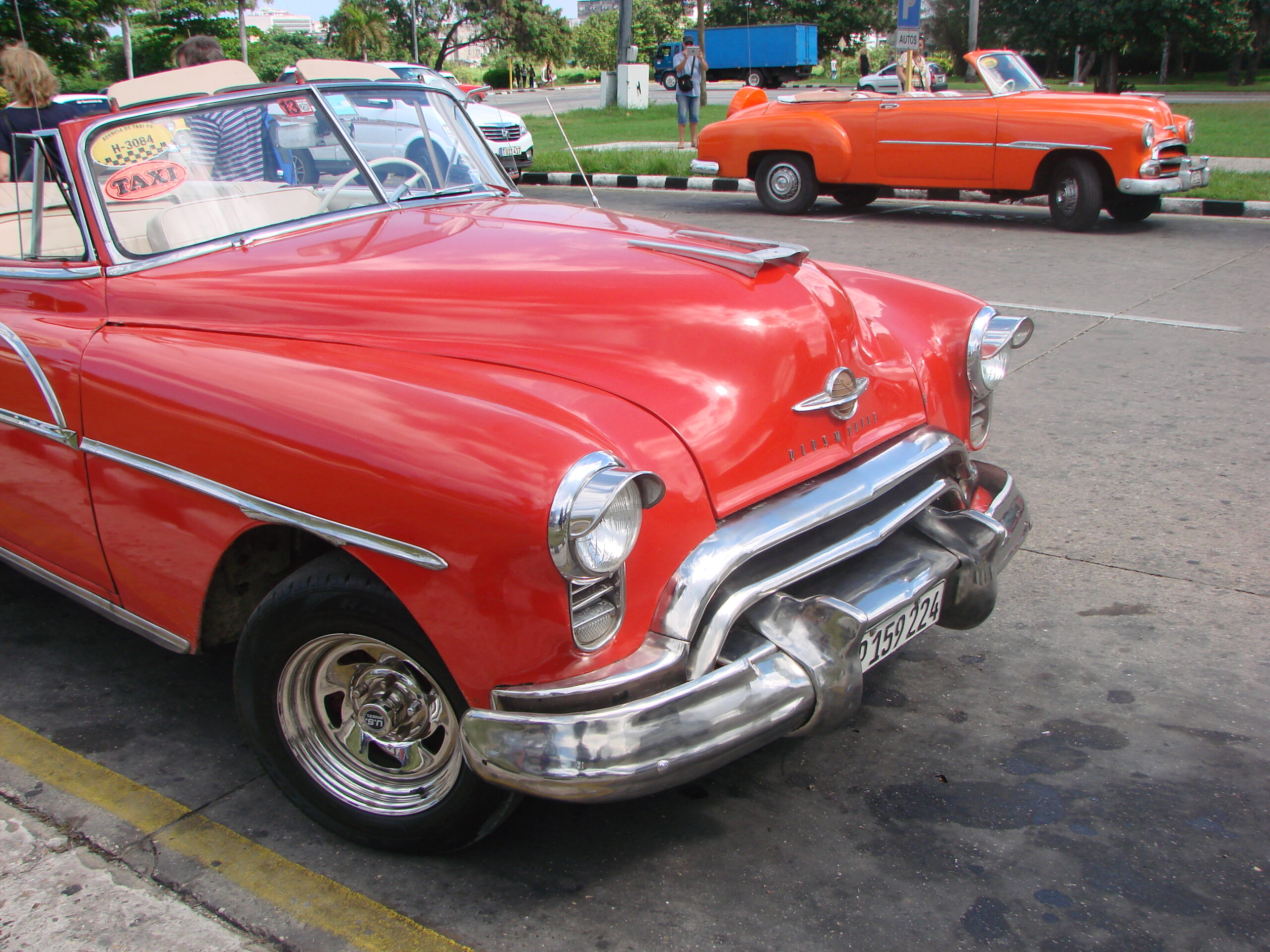
[caption id="attachment_87764" align="alignnone" width="3264"] A billboard of Che Guevera in the small Cuban town of Cárdenas. A. Hinkle photo.[/caption]
A billboard of Che Guevera in the small Cuban town of Cárdenas. A. Hinkle photo.[/caption]
By Annette Hinkle
Ninety miles. That’s roughly the distance between Sag Harbor and the Queens-Midtown Tunnel, and it’s all that separates the United States from Cuba.
Ninety miles — but it could just as easily be 9,000.
Half a decade of sour relations with the United States makes Cuba perhaps the last place on earth where Coca Cola doesn’t exist. And while there is a McDonald's — just one — it lies within the confines of the U.S. Naval Base at Guantanamo Bay.
But that may be about to change.
[caption id="attachment_87765" align="aligncenter" width="2592"] Classic American cars for hire. A. Hinkle photo.[/caption]
Classic American cars for hire. A. Hinkle photo.[/caption]
A year ago, President Obama announced plans to normalize relations with Cuba. As part of the thaw, this past summer the long shuttered U.S. embassy in Havana reopened and in recent months travel restrictions have been relaxed for Americans looking to visit the country.
So last week, a group of community journalists, myself included, traveled to Cuba with the New York Press Association to discover this place for ourselves. During our time there, we visited beaches, sugar plantations and the Bay of Pigs. We saw small towns and spent a night in Havana where evidence of the city’s revitalization is everywhere.
But like the parable of the blind men who encounter an elephant and offer very different accounts depending on which part of it they touch, Cuba remains a unique and mysterious animal — one shrouded in extremes and contradictions.
What you find in Cuba depends largely on where you go. Stay in a five star resort on the 20km long Varadero Peninsula two hours east of Havana, and you will have one experience. Venture away from the resorts and into nearby towns where the employees of those resorts live, like Santa Marta, Matanzas and Cárdenas (home of Cuban poster boy Elian Gonzalez) and you get a much different, and far more real, picture of Cuba.
[caption id="attachment_87766" align="alignnone" width="2592"] Cold War games. Rusting missile swings stand idle in an overgrown playground near Cardenas. A. Hinkle.[/caption]
Cold War games. Rusting missile swings stand idle in an overgrown playground near Cardenas. A. Hinkle.[/caption]
This is a country where even getting a straight answer to the most direct question can be difficult, which is why asking as many people as possible in as many ways as possible is the best technique for arriving at some version of the truth. Among those truths is the fact that Cubans no longer need state permission to travel abroad — just a passport. But with the average Cuban making $20 a month (there are separate currencies for locals and tourists) saving $100 to obtain a passport is nearly impossible, as is buying a plane ticket, unless a wealthy relative living abroad can provide the fare.
But Cubans with access to tourists and their CUCs (Cuban Convertible Pesos which are pegged to the U.S. dollar), are learning capitalism at the street level through wheeling and dealing while their compatriots in the countryside still survive on a salary based on the national peso (or CUP) which is worth one twenty fifth of the CUC.
That dual economy is now defining the place and this is a society beginning to see extremes. As more Cubans gain access to the Internet and understand how to profit from the tourist economy, will Cuba’s socialist ideals remain intact or will this become a society defined by the haves and the have-nots?
It’s a question many Cubans themselves are asking.
[caption id="attachment_87767" align="aligncenter" width="2592"] A boy and his horse in the town of Australia, Cuba. A. Hinkle.[/caption]
A boy and his horse in the town of Australia, Cuba. A. Hinkle.[/caption]
“Many people still believe blindingly in what the government says because they receive free education and medical care,” said one woman I met during my visit. “Quality of life has increased for some, but $18 to $20 is the average salary for most. They can live on that. They are happy because life is simple. They have no opportunity to see the outside world, but it’s enough.”
“Other people go out and see the world,” she continued, before adding, “The Chinese have a saying that when you go out of your land, horizons spread, and in my opinion, as long as people don’t have a way to travel it will stay the way it is.”
That may be some people’s dream and as stuck in time as Cuba is with its 1950s cars and mobster-era bars where you can hang out with statues of Hemingway and drink daiquiris and mojitos that haven’t changed in half a century, change is, nonetheless, inevitable and evidence of its arrival, for better and for worse, is everywhere you look in Havana.
Perhaps the change is starkest along the Malecón, Havana’s famous 8 km long seawall which looks north across the Strait of Florida and where Cubans gather nightly to socialize and escape the heat of the day. Across the boulevard facing the sea is a long stretch of colonial style buildings chock full of beaux art architectural details, covered vaulted porticos and massive double height windows.
[caption id="attachment_87768" align="alignright" width="450"] Palacio del Marqués de San Felipe y Santiago de Bejutal, a hotel in Havana's San Francisco d'Assis square. A. Hinkle.[/caption]
Palacio del Marqués de San Felipe y Santiago de Bejutal, a hotel in Havana's San Francisco d'Assis square. A. Hinkle.[/caption]
Abandoned long ago, nothing beyond the beautiful façades remains — no walls, no floors, no history and no memory. The empty shells serve as a metaphor to what’s been lost, but also represent the potential of what might be gained. As I look at my own reflection in the bus window, I can’t help but see my dual role as both the salvation and the demise of this most unique place. If U.S./Cuba relations continue to improve in the years ahead, as the Cuban people fervently hope they do, what will happen when American developers move in and have their way with the place?
Despite their decrepit state, looking at the beauty of these crumbled facades through the window of an air conditioned tour bus is heartbreaking. You can already see 10 years down the road when the place is vibrant with high end restaurants and nightclubs beckoning eager travelers from the United States who will spend their money and live the high life in a city once infamous for that kind of thing. Already, the darkness is punctuated every few blocks by a single hip looking eatery that is attracting the younger generation of Cubans.
This is a generation that has no memory or interest in the cold wars of old warriors and dead men. Cubans today are ready to move on, and when you stop and talk with a young person in Havana and tell them you’re from New York, their eyes light up as they talk about the cousins in America they have never met.
[caption id="attachment_87769" align="alignnone" width="3264"] Along the Maleçon in Havana. A. Hinkle.[/caption]
Along the Maleçon in Havana. A. Hinkle.[/caption]
I ask my woman friend if, after 50 years of the U.S. embargo, some people in Cuba harbor hostility toward the Americans.
“Even as young children, we were not taught to hate Americans,” she explained. “We know the American people have nothing to do with the government position. If foreign policy changes, Cuba will develop faster. It’s a good opportunity for American companies and Cubans.”
“The world is changing, and we are as well.”